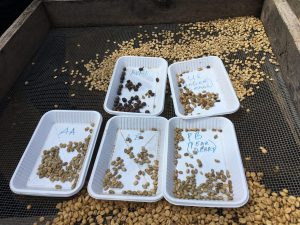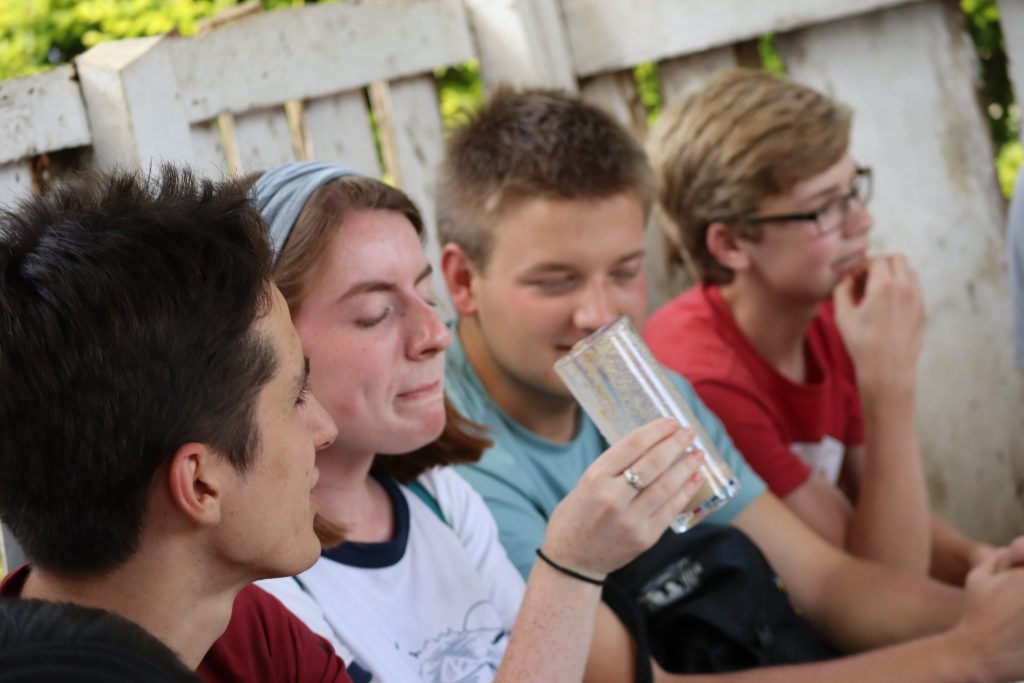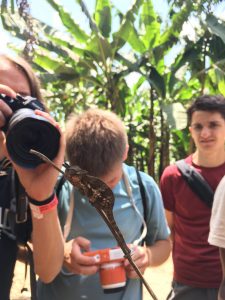Hiking, Healthcare, and Hard Conversations
Did you know that wine and beer can be made from bananas? Neither did I until this past Saturday! Our group of 20 split in half to go on some cultural excursions, and my half visited a rural village to hike and learn about how bananas and coffee beans are grown. Our guide Emmanuel greeted us with homemade banana crisps and smoothies and declared the day to be “Banana Day!” Brennan was particularly excited about this – the man has been known to eat five bananas in a single meal!

Emmanuel led us on a hike down winding trails that snaked in between various local farms and plantations, all the while pointing out different native plants. I learned how to identify yam leaves, avocado trees, papaya vines, wild carrots, and a plant with red fruit similar to raspberries. We also spotted a tiny chameleon! When we returned to the main center, Emmanuel demonstrated how banana and coffee plants are planted. The two crops are planted together because the bananas provide shade for the smaller coffee plants and both thrive in the warm Tanzanian climate. We also learned about how coffee beans are shelled, dried, and roasted and got to try our hand at all the stages of the process. The beans are shelled and ground in a giant mortar and pestle and then roasted over a fire.

Eventually we were able to drink a cup of the coffee we prepared! I don’t know if it’s because we helped to make it, or if it is really just that good, but it was one of the best cups of coffee I’ve ever had! We ended the day with a trip to the village pub to sample banana beer and wine. Neither one tasted much like bananas and both were very…yeasty. You can see from my face in this photo what I thought of the beer. Still, it was an excellent way to spend a Saturday and I will forever be mindful of the labor it takes to get my morning cup of coffee to my cup.

In class this week we have continued our discussions of public health in Tanzania and were able to experience some of what we’ve learned first-hand by visiting Selian Lutheran Hospital, a medical facility a little ways outside of Arusha. Our lectures this week have focused on HIV/AIDS care and prevention, and we were able to see the numerous programs that are targeting this issue at Selian. Dr. Criss, one of the HIV doctors showed us around the various CTC (care and treatment center for HIV) facilities: general, maternal, and pediatric. I was particularly inspired by the pediatric CTC. In addition to treatment, they offer counseling for parents and kids, a bi-monthly Saturday club, and education that helps kids gradually understand their diagnosis. The pediatric CTC was started by one woman named Mama Gloria, and in just a few years she grew the center from 7 patients to over 100. The colorful welcoming space was a testament to what a strong community with a vision for the future can do.
However, our hospital visits prompted some challenging class discussions about gender-based violence and the ways that women are treated in Tanzanian culture. One of our public health professors spoke about many of these issues in a cavalier manner, and sometimes with laughter which immediately turned me off to the rest of the class. While I know there were differing communication styles at play and nothing said was necessarily meant to be dismissive, I still struggled with how to feel about the class. In our debrief after class much of the conversation was of the theme “Well who are we to judge, we’re not from this culture.” While I agree that we need to be conscious of culture as travelers and outsiders, this left me feeling upset and unsatisfied. Where is the line between being aware of cultural factors and just tacitly excusing unjust practices simply because they have cultural roots?
This is a question that I am sure I will continue to grapple with throughout the rest of the semester, but for now my answer is this: I believe it is crucial to make an effort to understand the cultural roots of a given practice or norm, but that doesn’t mean I’m not allowed to have a personal opinion based on my values and ethics. Is it my place to voice that opinion in a judgmental manner? No, but guilt-tripping myself for having an opinion at all doesn’t help anything either. I’m learning that thinking critically about a culture is different than outward judgement based on a sense of western superiority, and there should be room for that critical thought in a traveling context.

Outside of class and excursions we have been having a lot of fun in our little corner of the neighborhood! One of my favorite moments from this week was getting up for a morning run with Zibby and being joined by six neighborhood children. I had met a few of them the day before on the sidelines of a soccer game and learned that they attend a boarding school for deaf children. Hanging out with them really put my non-verbal communication to the test, especially because they used a different system of sign language than the little bit of ASL I know. A smile and laugh goes a long way though, and I even got my own name sign: two taps on the arm, in reference to my freckles! I waved to them as I ran past, and instead of waving back they ran up and joined me in my laps around the field. At the end a few of them joined me for an impromptu yoga lesson, and there were many high fives before Zibby and I headed back to Mwangaza for breakfast.
This post marks the slightly-more-than-halfway-point of our time in Tanzania. We have a midterm for our public health class tomorrow, so I’ll have to stop writing soon to study! I’m a little sad to know that our time here is waning, but so excited for what else lies in store for the rest of our stay in this beautiful place.
— Grace Hermes ‘21
You must be logged in to post a comment.